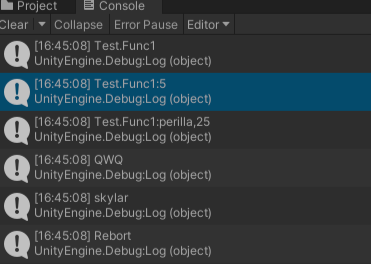一、反射
什么是反射
.Net的应用程序如下部分组成:‘程序集(Assembly)’、‘模块(Module)’、‘类型(class)’组成;
反射提供一种编程的方式,让程序员可以在程序运行期获得这几个组成部分的相关信息;
Type类可以获得对象的类型信息:方法、构造器、属性、字段;.
这些都包含在System.Reflection命名空间下;
程序集(assembly)
.dll编译好的库,里面可能有多个命名空间;.exe可执行文件;这两个种都是程序集;
模块(Module)
C#中没有模块,但提供了类似的功能:静态变量;
在C#中模块的另外一个含义是:
一种可加载单元,它可以包含类型声明和类型实现。模块包含的信息足以使公共语言运行库在模块加载时找到所有的实现位。模块的格式是 Windows 可移植可执行 (PE) 文件格式的扩展。在部署时,模块总是包含在程序集中;
个人觉得C#中没有太注重模块,有另一个概念,命名空间;将多个一类功能的类组合在同一命名空间下;
作用
运行期得到类型信息,修改属性或调用方法;
提高可扩展性;
二、反射方法
测试类,包含有参无参数构造;属性,方法,字段;
//测试类class Person{//构造public Person(){}public Person(string name){this.name = name;}//字段string name;int age;//属性public string Name{get{return name;}set{name = value;}}//方法public void SetName(string input){name = input;}}
获取字段
通过Type类可获得以下信息;
Person p = new PersonType t = typeof(p)//获取所有字段FieldInfo[] fieldInfos = type.GetFields();//获取单个字段FieldInfo fieldInfo = type.GetFields("name");fieldInfo.SetValue(p,"perilla")
获取属性
Person p = new PersonType t = typeof(p)//获取所有属性PropertyInfo[] propertyInfos = type.GetProperties();//获取单个属性PropertyInfo propertyInfo = type.GetProperty("Name");propertyInfo.SetValue(p,"perilla")
获取方法
Person p = new PersonType t = typeof(p)//获取所有属性MethodInfo[] methodInfos = type.GetMethods();//获取单个属性MethodInfo methodInfo = type.GetMethod("SetName");methodInfo.Invoke(p,"Perilla")
动态创建
Person p = new PersonType t = typeof(p)object obj = System.Activator.CreateInstance(t,"Perilla")//也可以获取构造通过构造创建
三、反射工具类
public class ReflectTool{#region 成员读写/// <summary>/// 通过参数列表,填充实体类型/// </summary>/// <param name="model">实体对象</param>/// <param name="objs">数据只读器</param>public static void FillInstanceValue(object model, params object[] objs){Type type = model.GetType();PropertyInfo[] properties = type.GetProperties();for (int i = 0; i < objs.Length; i++){properties[i].SetValue(model, objs[i], null);}}/// <summary>/// 通过kv参数表,填充实体类型/// </summary>/// <param name="model">实体对象</param>/// <param name="objs">数据只读器</param>public static void FillInstanceValue(object model, Dictionary<string,object> paramDic){Type type = model.GetType();PropertyInfo[] properties = type.GetProperties();for (int i = 0; i < paramDic.Count; i++){if (paramDic.ContainsKey(properties[i].Name)){properties[i].SetValue(model, paramDic[properties[i].Name]);}}}public static void FillInstanceField(object model, Dictionary<string, object> paramDic){Type type = model.GetType();FieldInfo[] fieldInfos = type.GetFields();for (int i = 0; i < paramDic.Count; i++){if (paramDic.ContainsKey(fieldInfos[i].Name)){Type it = fieldInfos[i].GetType();fieldInfos[i].SetValue(model, paramDic[fieldInfos[i].Name]);}}}/// <summary>/// 获取实体相关属性的值/// </summary>/// <param name="obj"></param>/// <param name="propertyName"></param>/// <returns></returns>public static object GetInstanceValue(object obj, string propertyName){object objRet = null;if (!string.IsNullOrEmpty(propertyName)){PropertyDescriptor descriptor = TypeDescriptor.GetProperties(obj).Find(propertyName, true);if (descriptor != null){objRet = descriptor.GetValue(obj);}}return objRet;}#endregion#region 方法调用/// 直接调用内部对象的方法/函数或获取属性(支持重载调用)/// <param name="refType">目标数据类型</param>/// <param name="funName">函数名称,区分大小写。</param>/// <param name="objInitial">如果调用属性,则为相关对象的初始化数据(带参数构造,只能调用Get),否则为Null。</param>/// <param name="funParams">函数参数信息</param>public static object InvokeMethodOrGetProperty(Type refType, string funName, object[] objInitial, params object[] funParams){MemberInfo[] mis = refType.GetMember(funName);if (mis.Length < 1){throw new InvalidProgramException(string.Concat("函数/方法 [", funName, "] 在指定类型(", refType.ToString(), ")中不存在!"));}else{MethodInfo targetMethod = null;StringBuilder pb = new StringBuilder();foreach (MemberInfo mi in mis){if (mi.MemberType != MemberTypes.Method){if (mi.MemberType == MemberTypes.Property){#region 调用属性方法GettargetMethod = ((PropertyInfo)mi).GetGetMethod();break;#endregion}else{throw new InvalidProgramException(string.Concat("[", funName, "] 不是有效的函数/属性方法!"));}}else{#region 检查函数参数和数据类型 绑定正确的函数到目标调用bool validParamsLen = false, validParamsType = false;MethodInfo curMethod = (MethodInfo)mi;ParameterInfo[] pis = curMethod.GetParameters();if (pis.Length == funParams.Length){validParamsLen = true;pb = new StringBuilder();bool paramFlag = true;int paramIdx = 0;#region 检查数据类型 设置validParamsType是否有效foreach (ParameterInfo pi in pis){pb.AppendFormat("Parameter {0}: Type={1}, Name={2}\n", paramIdx, pi.ParameterType, pi.Name);//不对Null和接受Object类型的参数检查if (funParams[paramIdx] != null && pi.ParameterType != typeof(object) &&(pi.ParameterType != funParams[paramIdx].GetType())){#region 检查类型是否兼容try{//TODO====这里有问题,实例是子类对象,参数是父类,父父类接口,无法转化,但是确实是参数;funParams[paramIdx] = Convert.ChangeType(funParams[paramIdx], pi.ParameterType);}catch (Exception){paramFlag = false;}#endregion//break;}++paramIdx;}#endregionif (paramFlag == true){validParamsType = true;}else{continue;}if (validParamsLen && validParamsType){targetMethod = curMethod;break;}}#endregion}}if (targetMethod != null){object objReturn = null;#region 兼顾效率和兼容重载函数调用try{object objInstance = System.Activator.CreateInstance(refType, objInitial);objReturn = targetMethod.Invoke(objInstance, BindingFlags.InvokeMethod, Type.DefaultBinder, funParams,System.Globalization.CultureInfo.InvariantCulture);}catch (Exception){objReturn = refType.InvokeMember(funName, BindingFlags.InvokeMethod, Type.DefaultBinder, null, funParams);}#endregionreturn objReturn;}else{throw new InvalidProgramException(string.Concat("函数/方法 [", refType.ToString(), ".", funName,"(args ...) ] 参数长度和数据类型不正确!\n 引用参数信息参考:\n",pb.ToString()));}}}/// 调用相关实体类型的函数方法/// <param name="refType">实体类型</param>/// <param name="funName">函数名称</param>/// <param name="funParams">函数参数列表</param>public static object InvokeFunction(Type refType, string funName, params object[] funParams){return InvokeMethodOrGetProperty(refType, funName, null, funParams);}#endregion#region 创建实例//通过Type创建实例,返回Objectpublic static object CreateInstance(Type refType, params object[] objInitial){object res = System.Activator.CreateInstance(refType, objInitial);return res;}//通过泛型T创建实例,并返回Tpublic static T CreateInstance<T>(params object[] objInitial) where T : new(){Type refType = typeof(T);object res = System.Activator.CreateInstance(refType, objInitial);if (res == null){Debug.LogError("Reflect create T is null");}return (T)res;}#endregion}
调用测试
public class Test{public Test() { }public Test(string name) { this.name = name; }private string name;public string Name {get {//Debug.Log($"PorperityGet:{name}");return name;}set {name = value;//Debug.Log($"PorperitySet:{name}");}}public void Func1(){Debug.Log("Test.Func1");}public void Func2(int para1){Debug.Log($"Test.Func1:{para1}");}public void Func3(string para1,int para2){Debug.Log($"Test.Func1:{para1},{para2}");}}void Start(){Test obj = new Test();Type t = obj.GetType();ReflectTool.InvokeFunction(t, "Func1");ReflectTool.InvokeFunction(t, "Func2", 5);ReflectTool.InvokeFunction(t, "Func3", "perilla", 25);object[] objs = new object[1];objs[0] = "perilla";ReflectTool.InvokeMethodOrGetProperty(t, "Name", objs);ReflectTool.InvokeFunction(t, "Name");obj.Name = "hhahah";ReflectTool.FillInstanceValue(obj, "QAQ");Dictionary<string, object> dic = new Dictionary<string, object>();dic["Name"] = "QWQ";ReflectTool.FillInstanceValue(obj, dic);Debug.Log(ReflectTool.GetInstanceValue(obj, "Name"));obj = ReflectTool.CreateInstance(t, "skylar") as Test;Debug.Log(obj.Name);obj = ReflectTool.CreateInstance<Test>("Rebort");Debug.Log(obj.Name);string str = " adfas dfaf ffff dsawee dff ";str = System.Text.RegularExpressions.Regex.Replace(str, @"\s", "");Debug.Log(str);Config config = ConfigTool.GetConfig<Config>(Application.dataPath+"/Config.cfg");Debug.Log($"ServerAddr:{config.ServerIp};Port:{config.Port}");}

